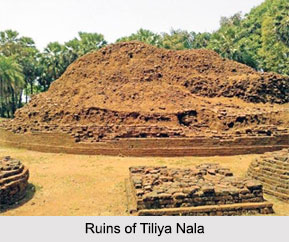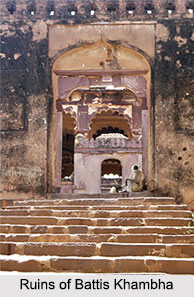 Ruins in Varanasi include Sarnath- the Buddhist stupas of early India, now maintained by Archaeological Survey of India. Other archaeological ruins are in Varanasi, Uttar Pradesh are Ruins of Tiliya Nala, Ruins of Battis Khambha, Dhamek Stupa ruins, Ruins of Battis Khambha, the ruins of Chunar fort, Ruins of Lat Bhairo, Ruins of Bakariya Kund and the Ruins of Stone Pillar.
Ruins in Varanasi include Sarnath- the Buddhist stupas of early India, now maintained by Archaeological Survey of India. Other archaeological ruins are in Varanasi, Uttar Pradesh are Ruins of Tiliya Nala, Ruins of Battis Khambha, Dhamek Stupa ruins, Ruins of Battis Khambha, the ruins of Chunar fort, Ruins of Lat Bhairo, Ruins of Bakariya Kund and the Ruins of Stone Pillar.
Ruins of Tiliya Nala
Ruins of Tiliya Nala are located in Varanasi, Uttar Pradesh. It is located just above the nala or stream, on the high ground of its left bank of Ganga River. Ganga River is located in the vicinity of the stream. Tiliya Nala has the earlier extension which spread across its present bed. They consist of seventeen massive square columns, in three rows.
Ruins of Battis Khambha
 Ruins of Battis Khambha are located in Varanasi about a third of a mile to the east of the Bakariya Kund. The Battis Khambha, as called by the natives or "thirty-two pillars" is a small structure that looks very attractive. It is almost four hundred yards away from the Raj Ghat road.
Ruins of Battis Khambha are located in Varanasi about a third of a mile to the east of the Bakariya Kund. The Battis Khambha, as called by the natives or "thirty-two pillars" is a small structure that looks very attractive. It is almost four hundred yards away from the Raj Ghat road.
Ruins of Chaukhambha Mosque
The ruins of Chaukhambha Mosque are situated in the city of Varanasi. It has four low massive pillars towards its north eastern extremity. These are carved in modern architectural type and can be seen standing in the lowermost storey of a lofty building.
There is a narrow court running out of this street that ends in a small enclosure. Chaukhambha Mosque can be seen further towards this street. The entire enclosure of Chaukhambha Mosque looks very appealing and attractive. Chaukhambha Mosque can be entered through a doorway that leads to a path with walls formed of blocks of stone. The wall is twenty feet long, thirteen feet high, and four feet thick. It has been constructed analytically. The stones of the mosque have been placed with much care one close to another. Over the doorway is an inscription written in Arabic language which proves the antiquity of this place. However, apart from the doorway and the castellated structure that surmounts the wall that structural design of the mosque does not relate to the architectural pattern of the Muslims.
Ruins of Bakariya Kund
The ruins of Bakariya Kund are situated at the North West corner of the city of Varanasi. Bakariya Kund is in the Alipore Mahalla, and can be seen from the Raj Ghat road leading from the cantonments to the Ganga River. The tank of Bakariya Kund is situated about three hundred yards distant from the main road. The ruins can be seen upon the summit of its banks in the main. During summer very little water remains in Bakariya Kund. But during the rainy season Bakariya Kund holds a huge amount of stream which supplied water during medieval era. The Kund is about five hundred and fifty feet in length, and two hundred and seventy-five in breadth.
Ruins of Stone Pillar
The ruins of Stone Pillar are located between the city of Varanasi and the Buddhist remains at Sarnath. It was erected in the midst of a tank. The tank is also known as Sone ka Talao, or the Golden Tank. In this site, Chaukhandi Stupa and Dhamek Stupa are the major tourists" delight. It is situated on the opposite side of the Barna River, near the road which deviates from the high road leading to Ghazipur. This road is part of the famous road of Panchkosi, the sacred boundary of the city of Varanasi. By taking this route one needs to cover less than a mile to reach the tank that falls on the right hand side. There is a well built near the Stone Pillar of Sarnath. There are several Buddhist figures that can be seen here carved beautifully. These are thought to have been brought from Sarnath.



















